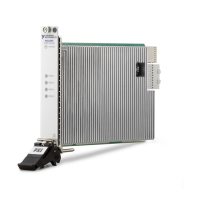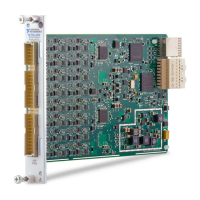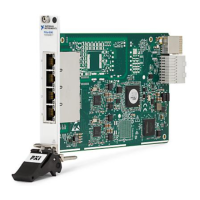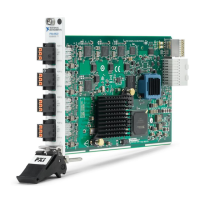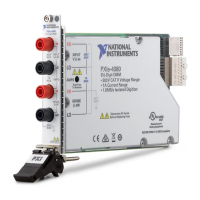© National Instruments | 3-17
NI PXI-6683 Series User Manual
Asynchronous routing works well if the total system delays are not too long for the application.
Propagation delay could be caused by the following reasons:
• Output delay on the source
• Propagation delay of the signal across the backplane(s) and cable(s)
• Propagation delay of the signal through the NI PXI-6683 Series
• Time for the receiver to recognize the signal
The source of an asynchronous routing operation on the NI PXI-6683 Series can be any of the
following lines:
• Any front panel PFI pin (PFI<0..2>)
• Any PXI Star trigger line (PXI_STAR<0..12>) (NI PXI-6683 only)
• Any PXI Trigger line (PXI_TRIG<0..7>)
• Synchronized time events
• PXI_CLK10
• Ground
Tip Invert Ground to get a logic high.
The destination of an asynchronous routing operation on the NI PXI-6683 Series can be any of
the following lines:
• Any front panel PFI pin (PFI<0..2>)
• Any PXI star trigger line (PXI_STAR<0..12>) (NI PXI-6683 only)
• Any PXI Trigger line (PXI_TRIG<0..7>)
Synchronous Routing
A synchronous routing operation is defined in terms of three signals: a source, destination, and
a synchronization clock. Unlike asynchronous routing, the output of a synchronous routing
operation does not directly follow the input after a propagation delay. Instead, the logic state of
the input is sampled on each rising edge of the synchronization clock and the output is set to the
logic state after a small delay, as shown in figure 3-7. Thus, the output is said to be
synchronous with this clock.
The PXI-6683 Series supports inverting the polarity of the routed signals; this can be useful
when handling active-low digital signals.
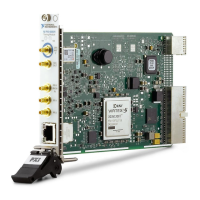
